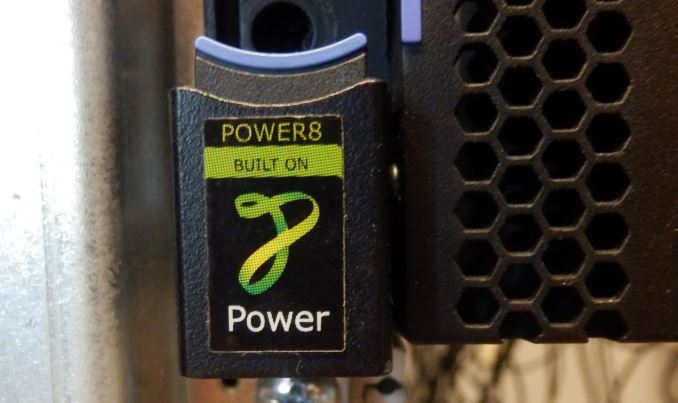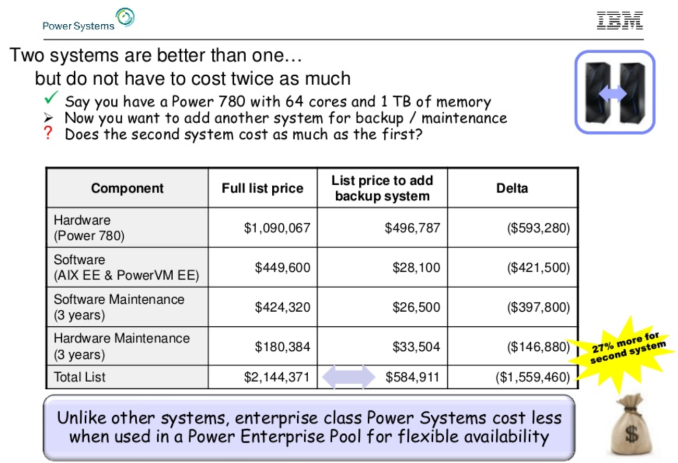The IBM POWER8 Review: Challenging the Intel Xeon
by Johan De Gelas on November 6, 2015 8:00 AM EST- Posted in
- IT Computing
- CPUs
- Enterprise
- Enterprise CPUs
- IBM
- POWER
- POWER8

Five years. That is how much time has passed since we have seen an affordable server processor that could keep up with or even beat Intel's best Xeons. These days no less than 95% of the server CPUs shipped are Intel Xeons. A few years ago, it looked like ARM servers were going to shake up the market this year, but to cut a long story short, it looks like the IBM POWER8 chip is probably the only viable alternative for the time being.
That was also noticeable in our Xeon E7 review, which was much more popular than we ever hoped. One of the reasons was the inclusion of a few IBM POWER8 benchmarks. We admit that the article was however incomplete: the POWER8 development machine we tested was a virtual machine with only 1 core, 8 threads and 2 GB of RAM, which is not enough to do any thorough server testing.
After seeing the reader interest in POWER8 in that previous article, we decided to investigate the matter further. To that end we met with Franz Bourlet, an enthusiastic technical sales engineer at IBM and he made sure we got access to an IBM S822L server. Thanks to Franz and the good people of Arrow Enterprise Computing Solutions, Arrow was able to lend us an IBM S822L server for our testing.
A Real Alternative?
Some of you may argue that the POWER based servers have been around for years now. But the slide below illustrates what we typically associated IBM's POWER range with:
Proudly, the IBM sales team states that you can save 1.5 million dollars after you have paid them 2 million dollars for your high-end 780 system. There is definitely a market for such hugely expensive and robust server systems as high end RISC machines are good for about 50,000 clients. But frankly for most of us, those systems are nothing more than an expensive curiosity.
Availability can be handled by software and most of us are looking/forced to reduce our capital expenses rather than increase them. We want fast, "reliable enough" servers at low costs that are easy to service. And that is exactly the reason why the single and dual sockets Xeon servers have been so popular the past decade. Can an IBM POWER server be a real alternative to the typical Xeon E5 server? The short but vague answer: a lot has changed in the past years and months. So yes, maybe.











146 Comments
View All Comments
JohanAnandtech - Saturday, November 7, 2015 - link
Ok, Europe adopt the dot, but maybe the US can adopt the metric system like the rest of the world? :-)bitaljus - Saturday, November 7, 2015 - link
or better yet recode this site to see from what country u are visiting and use the appropriate denote thousands symbol, appropriate metric system and even time for the viewer. how meany time i was irradiated when i need to google something like this just to make it in local. and this is easy to do in the site natively. (P.S. Sorry for bad English, not native)nils_ - Wednesday, November 11, 2015 - link
The browser already sends a header with Accept-Language, which should be the preferred way to for the web site to determine locale. For example, I live in Germany so my browser will send en, en_UK, en_US, de and DE (this can be set somewhere in the settings). Now you can determine the language and other localisation based upon that, and there are tools where you can set the locale to then display dates, times etc.. based n that.Many sites instead use Geolocation based on the IP address, which can be really awkward when you travel to a country where you can't read the language.
ZeDestructor - Saturday, November 7, 2015 - link
Even within EU it's not consistent.. UK uses commas for thousands, dot for decimal (and that's why the US and most anglophone countries use the same setup), Germany, Netherlands and France on the other hand favour dots for thousands, commas for decimal, so you see it used there.. and in a great number of their former colonies where the language and culture has stuck.nils_ - Wednesday, November 11, 2015 - link
Dates / Time are even funnier, that's also extremely inconsistent and can be very misleading. Think for examle a date like 12/11/2015, in some countries it'll mean the 12th of November while in others it will mean the 11th of December, and sometimes even the 2015th of November in 11 AD ;)I remember reading on the GTA IV in-game "Internet" a travel guide to Europe that said the months here have 12 days but there are 30 months a year or something to that effect ;)
powchie - Friday, November 6, 2015 - link
let Johan do more reviews. been reading his stuff from late 90's and consider him the best then followed by Anand.Ryan Smith - Saturday, November 7, 2015 - link
Trust me when I say that if I could whip Johan any harder and make him work any faster I would be doing just that.;-)juhatus - Saturday, November 7, 2015 - link
When the Balrog showed up for work he had everyone fired.ruthan - Friday, November 6, 2015 - link
In summary should be something about software support, raw power is here, but software stack isvery limited.
PowerCPU is good for old legacy apps - SAP, Oracle etc.. but otherwise its dead end.
I would like to see comparision of IBM LPAR virtualization against Xeon Vmware solution, or Oracle / MySQL benchmark on power vs. Oracle benchmark on Xeon.
Server with Power even cant to run Crysis, or maybe some QEMU magic..
ruthan - Friday, November 6, 2015 - link
Pleas Ad edit button like other civilized sites, i was hurry when i wrote it.